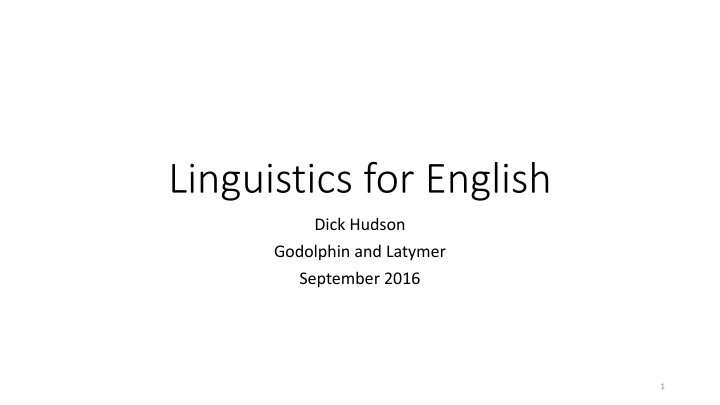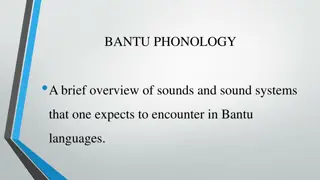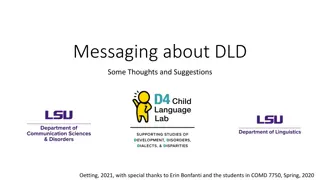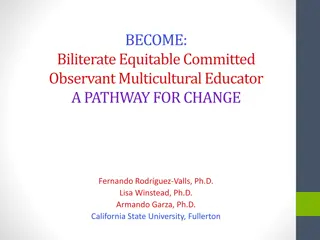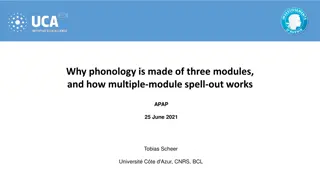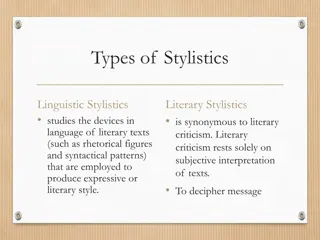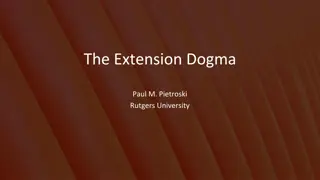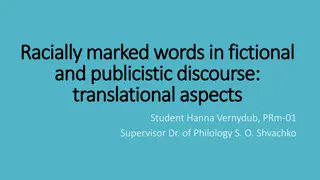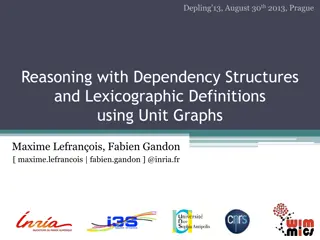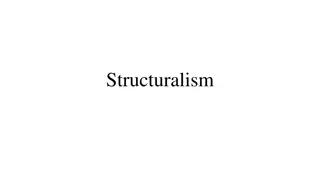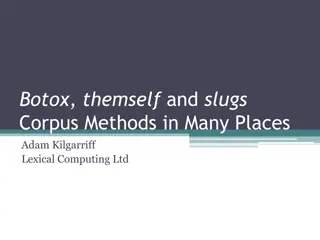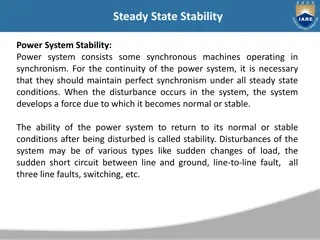Linguistic Stability and Change: Insights from English
Language is remarkably stable from one generation to the next, with children learning to speak like their parents. However, it does evolve slowly over time and rapidly in certain circumstances such as borrowing and innovation. The Great Vowel Shift in English serves as an example of both gradual and rapid linguistic change, highlighting the intricacies of language evolution through generations.
Uploaded on Oct 02, 2024 | 0 Views
Download Presentation

Please find below an Image/Link to download the presentation.
The content on the website is provided AS IS for your information and personal use only. It may not be sold, licensed, or shared on other websites without obtaining consent from the author.If you encounter any issues during the download, it is possible that the publisher has removed the file from their server.
You are allowed to download the files provided on this website for personal or commercial use, subject to the condition that they are used lawfully. All files are the property of their respective owners.
The content on the website is provided AS IS for your information and personal use only. It may not be sold, licensed, or shared on other websites without obtaining consent from the author.
E N D
Presentation Transcript
Linguistics for English Dick Hudson Godolphin and Latymer September 2016 1
Main messages Language is extraordinarily stable from generation to generation So children learn to speak just like their parents But it does change in two ways: slow change fast change 2
Plan 1. Linguistic stability and change 2. Child language acquisition (CLA) 3. Language variation 4. Variable CLA in Buckie, Scotland 5. The Linguistics Olympiad 3
1. Linguistic stability and change Language is extraordinarily stable from generation to generation but there is some very slow change But some things cause very fast change borrowing innovation e.g. for technology For example: From PIE to ME The Great Vowel Shift 4
generations guessed PIE From Proto-Indo-European to Modern English *gwe:n woman -3,500 0 Greek /gyne:/ woman -500 120 borrowed cwen woman 160 +600 English gynaecologist misogyny +2,000 200 queen 5
The Great Vowel Shift 1350-1700 bite after bite before as in kwen before after bite /i / /a / meet /e / /i / meat / / mate /a / /e / out /u / /a / as in queen boot /o / /u / boat / / / / 6
bite before bite after Vowels in the mouth as in queen as in kwen 7
So what? Long vowels changed, but short vowels didn t. That s one of the reasons why English spelling isn t phonetic . Sometimes the spelling shows the links between long and short pairs. / :/ > /i:/ deep ~ depth (weep ~ wept, clean ~ cleanse) same vowel-letter because they used to have the same vowel-sound /i:/ > /ai/ wide ~ width (five ~ fifth, fifty, hide ~ hidden) Ibiza = /aibi / 8
How fast does language change? Very slowly The Great Vowel Shift took 350 years = (3.5 x 4 = 14) generations. The meaning of gwe:nstayed the same ( woman ) for 4,000 years = 160 generations! Why? Because we want to conform. Very fast Gynaecology invented 1847 when gynaecology itself was being invented teen-age slang e.g. say = ? good = ? 9
2. Child Language Acquisition (CLA) video from https://www.youtube.com/watch?v=CB5XSQi6Qhg 10
CLA: questions for a beginner 1. What sounds do people make? 2. When do people make those sounds? 3. What do people make those sounds for? 4. How can I make those sounds? 5. How can I use those sounds to communicate? 6. What do those sounds mean? 7. How can I sound just like Mummy? 11
3. Language variation Within any language, there s variation: dialects, used by different people registers, used in different situations. Sometimes the variation is qualitative: each person or group uses just one form each register allows just one form E.g. traditional dialects 12
Two isoglosses in southern England London 13
Why do we vary? For identity We need a social identity defined in terms of social groups We need to communicate this identity by using the signals of our group But social life is complicated we all belong to many groups we belong to any group to some degree. 14
Quantitative variation Quantitative variation still communicates identity. But different linguistic variables communicate different identities. each variable contrasts two or more alternative variants e.g. come = [ ] or [ ]: North vs South farm = [a:] or [a:r]: East vs West And each variable links different frequencies to different groups e.g. easterners and westerners both use /fa:m/, but with different frequencies. 15
So most variation is quantitative Given a choice between two forms, people use both, but in different quantities. e.g. ou = [a:] or [a ] audio from https://www.youtube.com/watch?v=Q5MtlR1I 20M Spot the linguistic variables! 16
4. Variability and CLA in Buckie, Scotland Research by Jennifer Smith and colleagues. 17
Variability in Buckie [u:] The HOOSE (house) variable: [ ] or [u:] Adults speaking to each other only use [u:] But mothers often use [ ] when talking to children. E.g. mother and child 4:25 minutes into the recording: [u:] [ ] audio from audio from http://www.scottishcorpus.ac.uk/document/?documentid=1599 18
CLA in Buckie: measuring the HOOSE variable All recordings involved one caregiver and one child. 11 pairs children 2;10 3;6. Scoring the variation: count [u:] as percent of [u:] + [ ]. Caregivers average: 43% Children average: 37% 19
mothers differ children track their mothers Results mother three youngest children, about 3;0 20
So what? Adults choose their score to match the addressee: to an adult: only [u:] to a child: either [u:] or [ ]. At age three, children learn to match their adult model. So they are variable too. And their variable score is close to their adult model s! A marvel of social adjustment and precision learning. 21
